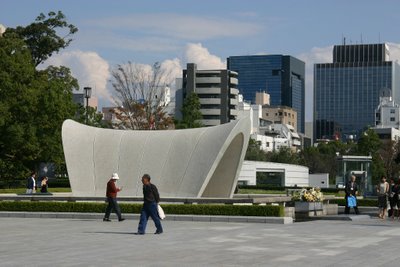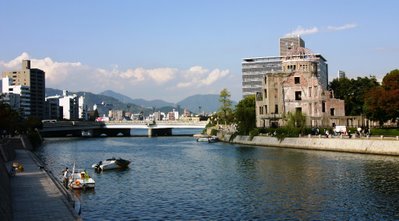Shopping seems to be the national pastime of
Japan. Every city has a massive shopping district where the entire populace spends the evening hours strolling, talking, eating and drinking. The noise and crowds take some getting used to. Walking along the narrow streets requires constant vigilance to prevent collisions with people or being hit by the thousands of bicycles that wend their way through the crowds. It’s a mystery how they do it.
This weekend that mystery was compounded by my location. I’d gone to a town in southern Honshu, the main island of Japan, to try to escape from the bustle of Tokyo only to find myself immersed in the same press of crowds in a city only marginally less densely populated. I hadn’t expected that. Sixty years ago this city was utterly destroyed by American bombing during the last days of WWII. It was projected never to exist again. Yet here was Hiroshima, not just raised from the ashes, but completely devoid of any trace of the nuclear event that killed half of its citizens.
The next day, I walked from the train station to Peace Memorial Park located at the hypocenter of the atomic blast. Along the way I came to a small memorial. A fraction of a hospital building had been preserved and placed so passersby could marvel at the bent steel frames of the windows. Beside it was a small fountain. Beneath the fountain, visitors had left bottles of water.
Water is a symbol of the suffering of the atomic bomb victims. An estimated 80,000 people died within a few days of the bombing. The lucky ones died without knowing what happened but many, many suffered both thermal and radiation burns. These people, their skin hanging like threads from their bodies, begged for water as they died. The stories of survivors chronicled at the memorial all relate this same horror.
Peace Memorial Park’s green lawns, flower beds and rows of shade trees belie the prediction that nothing would grow in the shadow of the bomb for 75 years. Looking around, it is hard to imagine the devastation and suffering. The story is told within the walls of the museum, in the names of the victims recorded in the cenotaph (an estimated 140,000 by the end of 1945 and now around 200,000 as a result of cancers and other illnesses related to the bomb), in the thousands of paper cranes cram the memorial to Sadako Sasaki, and the A-Bomb Dome.
Little Boy, the name given the nuclear device that destroyed Hiroshima, detonated 600 feet above the building that is now the A-Bomb Dome. Everyone in and around the building died, incinerated by the nearly instantaneous rise of 7,000 degrees F generated by the bomb. Most of the remainder of the city was flattened to rubble, but the shell of the A-Bomb Dome remarkably survived and is now preserved. Staring through the framework of the dome at the high rise buildings behind it, I wonder two things: why didn’t they preserve more and why did they rebuild here at all?
I guess I know the answers to both questions. The Japanese are amazingly resilient, as all people can be when they are driven to it. This was their home, the home of their parents and their parents’ parents. That history cannot be discarded. At the same time, the constant reminder of death and destruction does not lend itself to healing. The people needed to move forward. Some would have chosen to preserve nothing to remind them of that day, others warn that such things cannot be forgotten least they be repeated.
A crowd of uniformed schoolchildren passed behind me on a tour of the park. They were laughing, jostling with each other, hardly looking at the dome. Certainly not thinking of the people--possibly their own ancestors—who suffered here. Not thinking that the ground under them was once radioactive. Do these children ever worry that their city might be attacked again one day? Has the threat of nuclear weapons from North Korea registered on them?
I guess a bigger question is has it registered on us? I wish our politicians would all visit the museums of Hiroshima.
For more information on the museum and park:
http://www.pcf.city.hiroshima.jp/virtual/
Drawings made by A-bomb survivors:
http://www.blackshipsandsamurai.com/GroundZeroColl2/index.htm
Photo: Inside the Memorial Hall.
The walls show a 360 degree view of
Hiroshima not long after the bombing. The mural is made of 140,000 tiles, each representing an individual who died. The object in the center is a fountain to sate the thirst of the victims.

Photo: Hiroshima cenotaph
The cenotaph holds the names of all of the victims of the atomic bomb. Modern Hiroshima rises in the background.
Photo: The A-Bomb Done
The bridge in the background was the actual target of the bomb.




3 comments:
I like this new blog home. It looks really professional and much easier to read. And it doesn't lie when it says you don't need an account to view.
The article itself is very thought provoking with underlying political tones which is not glaringly patent. I like it a lot. The only thing is that though the article is gruesome in some places, the photos are all bright and cheerful and very modern. It's an interesting contrast.
Did you follow the links? Some of those are very gruesome.
You are keeping in touch with some Amazing tips. This article truly helped me a ton. A debt of gratitude is in order for sharing this blog.
depression therapy delray beach | couples therapy delray beach
Post a Comment